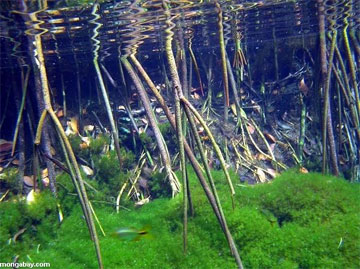20% of the world’s mangroves lost since 1980
Rhett A. Butler, mongabay.com
November 11, 2005

20% of the world’s mangrove forests have disappeared since 1980 according to a new study by the Food and Agriculture Organization of the United Nations (FAO).
Mangrove forest is found in silt-rich, saline habitats worldwide, generally along large river deltas, estuaries, and coastal areas. It is characterized by low tree diversity, almost exclusively mangroves, with a low broken canopy. Mangroves are evergreen trees and shrubs that are well adapted to their salty and swampy habitat by having breathing roots (pneumatophores) that emerge from the oxygen-deficient mud to absorb oxygen.
Mangrove forests and “swamps” are important as spawning grounds and nurseries for marine and freshwater species. Mangroves also help prevent and reduce coastal erosion and storm damage, as seen in the aftermath of the 2004 tsunami in southeast Asia.
Their location combined with their low perceived value makes mangrove forests prime targets for for development. Today mangroves are rapidly disappearing (at rates exceeding those of tropical rainforests) due to farming, harvesting for timber and charcoal, freshwater diversion, real estate development, and conversion for tourism. The Environmental Justice Foundation estimates that as much as 38% of global mangrove deforestation is linked to shrimp farm development.
The following is a news release from FAO detailing its mangrove study.
Twenty percent of the world’s mangroves lost over the last 25 years: Rate of deforestation slowing, but still a cause for alarm
Around 20 percent of the world’s mangrove forests have disappeared during the past 25 years as a result of over-exploitation and conversion to other uses, according to a new FAO study.
Mangroves today cover around 15 million hectares (ha) worldwide, down from 18.8 million ha in 1980, according to the study. Still, during the same time frame the annual rate of mangrove deforestation dropped from around 185 000 ha per year in the 1980s to 105 000 ha/yr during the 2000-2005 period, it added.
“More countries are now recognizing the importance of mangroves and are making an effort to conserve and better manage them,” said Mette Løyche Wilkie, a mangrove expert at FAO. “Yet the true value of mangroves and other wetlands is still underestimated and much remains to be done to reduce the rate of loss, which is significantly higher than for other forest types,” she added.
Key findings of FAO report to be discussed at Uganda meeting on wetlands
 Underwater photo of mangrove roots in the Yucatan, Mexico. Photo by R. Butler. |
The key findings of the report were presented today at the Conference of the Parties to the Ramsar Convention on Wetlands, which began yesterday in Kampala, Uganda (8-15 November 2005).
The report, to be published next January, will provide an overview on mangrove vegetation and species, uses and threats in addition to information on mangrove areas and area changes over time. It is prepared by FAO in collaboration with mangrove specialists throughout the world and is co-funded by the International Tropical Timber Organization (ITTO).
A misused resource
Because they are located in coastal zones, where population densities are typically high, mangrove areas are frequently converted to other uses, including fish and shrimp-farming, agriculture, salt production and urban development.
In the past, many governments actively encouraged such development of mangrove areas in order to strengthen food security, boost national economies and improve living standards.
Over the last few years, however, an increased awareness of the wider value of mangrove ecosystems has led to new legislation, better protection and management of mangrove resources and, in some countries, a re-expansion of mangrove areas, according to FAO.
Mangroves are found in more than 120 countries and territories around the world, but the UN agency noted that close to half of the total mangrove area is found in just five countries: Indonesia, Australia, Brazil, Nigeria and Mexico. Asia has the largest area of mangroves, followed by Africa and South America.
Mangroves provide wide range of benefits
Mangroves are salt-tolerant forest ecosystems commonly found along sheltered coastlines, in deltas and along river banks in the tropics and sub-tropics. Millions of fishermen, farmers and others depend on them as a source of wood, medicinal plants, and food.
One important function of mangroves is to serve as spawning grounds and nurseries for fish and shellfish and they play an important role in the marine foodweb. When mangrove forests are destroyed, drops in local fish catches often result.
These unique forest ecosystems provide a number of additional environmental benefits, as well. Mangroves help prevent and reduce coastal erosion, providing nearby communities with protection against the effects of wind, waves and water currents. This was the case during the 2004 tsunami in Asia where evidence indicates that where extensive areas of mangroves existed, coastal villages suffered less damage.
This is a modified press release from FAO